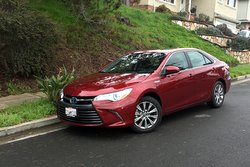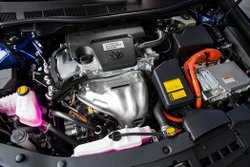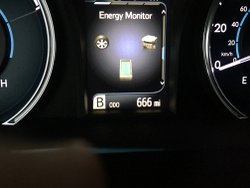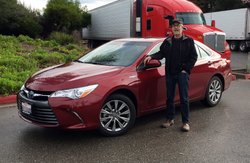Making Popular Greener
The midsize Toyota Camry sedan has enjoyed the top spot in car sales in the U.S. for the last 14 years. Now in its 35th year and seventh generation, it remains a hit.

What folks may not know is that Toyota sells lots of other hybrids besides the Prius. There’s an Avalon, Highlander, and RAV4 Hybrid offered—and even a Camry model. While it’s not as fuel efficient as the Prius, the 2017 Toyota Camry Hybrid still is significantly greener than the gasoline-only models.
The latest Camry was significantly restyled a couple of years ago, and flaunts the ferocious mouth that all Toyotas bare now. There’s more texture to the side panels, and the overall look carries a little more flair than before.
Inside, every Camry features a swirling flow of curves and overlapping panels that’s stimulating to the eye. The dash and door wear the requisite stitching that reads “upscale” today. Materials are good but are below, say, an Audi for fineness.
The Hybrid Power Option
Regular Camrys come with either a 178-horsepower, 2.5-liter four-cylinder engine (with 170 lb.-ft. of torque) or a 268-horsepower, 3.5-liter V6 (with 248 lb.-ft. of torque).

The third option is the hybrid Synergy Drive System, which combines a 2.5-liter four with a 105-kW electric motor to net 200 horsepower.
Like a good hybrid, it’s programmed to use electricity or gasoline depending on the driving situation. It can use only battery power when, say, cruising down a 25-mph suburban street. In fact, you can select the EV Mode button and, for up to 1.6 miles at speeds below 25 mph, tell the gas engine to take a break.
I drove my Ruby Flare Pearl test car just as I would any other vehicle. I could hear the gas engine start up when I got on the freeway, but I also noticed that if was in slow commute traffic or on streets in town, the battery would often be turning the wheels. The car’s computer makes the decision, but you can guide it by applying the accelerator gently and braking considerately.
The 2017 Toyota Camry Hybrid shoots from 0-60 mph in just 7.6 seconds, which is relatively speedy. You do lose some trunk space for the battery, but otherwise, you really don’t see the difference. I was still able to stash a bass guitar and small amplifier in there.
The Levels of Camry
Like other Camrys, the Hybrid comes in multiple levels. The base car is the LE, but there’s a sporty SE or the top-level XLE, like my test car. The LE includes such things as dual climate control, a backup camera, cruise control, power windows and locks, and a modern Optitron instrumentation display.

Step up to the SE for 17-inch alloys instead of 16-inch steel wheels. And, you get a sport tuned suspension, leather-wrapped steering wheel, power seats and other style enhancements.
The XLE gives you leather chairs, the Entune 10-speaker Audio Plus system with navigation and much more. You decide.
The EPA’s ratings are a major part of driving a hybrid. The agency claims that the Camry Hybrid gets 40 mpg city/37 highway/38 combined, which puts it in our 40 MPG Club. Compare that to the four-cylinder Camry, which earns 24 mpg city/33 highway/27 combined. I averaged a disappointing 28.9 mpg.
The 2017 Toyota Camry Hybrid, unlike other Camrys, uses a continuously-variable automatic transmission (CVT). CVTs use belts instead of gears to come up with the ideal ratio anytime depending on driving conditions, including accelerating on to the freeway or starting up a hill. You can set the transmission in “B” for more regenerative braking, and the car will slow down a little when you lift off the accelerator, generating some power to recharge the battery.
You can select a driving mode—Eco, Normal, or Sport. I used Eco mostly. It mutes accelerator response and lowers the climate control to improve fuel efficiency.
The Bottom Line—And Add-Ons

Pricing for the LE with nothing extra begins at $27,655. The XLE starts at $31,005. But wait! You can add in a lot of extras to a Camry Hybrid. How about Safety Connect, with stolen vehicle locator and emergency assistance? A blind spot monitor system? The Homelink transceiver and a theft alarm? The Entune Premium JBL system adds tons of features and apps. The Advanced Technology Package brings with it a pre-collision system, dynamic radar cruise control, and automatic high beams. When you start piling on the goodies, you get a test car like mine, with a $36,351 price tag.
What’s not to like about a midsize sedan like the 2017 Toyota Camry Hybrid? There’s plenty of room for you and three or four other folks. You will not stand out in any way from the mass of travelers, of course, but that’s not what Camrys do. They efficiently, for their size, provide reliable transportation and a minimum of fuss.
Related Stories You Might Enjoy:
All-Wheel Drive Cars with Best Mileage
Road Test: 2017 Kia Optima Hybrid
First Drive: 2017 Kia Niro Hybrid
News: 2017 Hyundai Ioniq Hybrid Becomes Fuel Economy Leader
Road Test: 2016 Toyota Prius Liftback
Road Test: 2017 Honda Accord Hybrid
Disclosure:
Clean Fleet Report is loaned free test vehicles from automakers to evaluate, typically for a week at a time. Our road tests are based on this one-week drive of a new vehicle. Because of this we don’t address issues such as long-term reliability or total cost of ownership. In addition we are often invited to manufacturer events highlighting new vehicles or technology. As part of these events we may be offered free transportation, lodging or meals. We do our best to present our unvarnished evaluations of vehicles and news irrespective of these inducements.
Our focus is on vehicles that offer the best fuel economy in their class. We also feature those that are among the top mpg vehicles in their class. In addition, we aim to offer reviews and news on advanced technology and the alternative fuel vehicle market. We welcome any feedback from vehicle owners and are dedicated to providing a forum for alternative viewpoints. Please let us know your views at publisher@cleanfleetreport.com.

3 thoughts on “Road Test: 2017 Toyota Camry Hybrid”